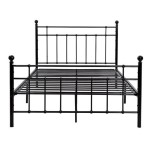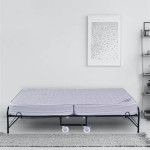How to Make Bed Rails for a Toddler
Toddler beds can be a source of both excitement and anxiety for parents. The freedom of a "big kid" bed is often met with the fear of falls and tumbles. Bed rails are an excellent solution to bridge this gap, providing a sense of security while allowing your child to enjoy their newfound independence. While commercially available bed rails are readily accessible, crafting your own offers a personalized touch and a sense of accomplishment. This guide will walk you through the process of making bed rails for your toddler's bed, equipping you with the knowledge and steps needed to create a safe and comfortable sleeping environment.
1. Choosing the Right Materials
The first step in crafting bed rails is selecting the appropriate materials. The key considerations are safety, durability, and aesthetic appeal.
Wood:
A classic choice due to its strength and versatility. Look for hardwoods like maple, oak, or cherry for their durability and resistance to scratches. Softwoods like pine are also suitable, but may require additional reinforcement.
Metal:
Metal offers a sturdier option, with options like aluminum or steel offering resistance against bending and warping. However, metal can be heavier and may require additional safety measures to prevent sharp edges.
Fabric:
Consider using a softer fabric like cotton or fleece for padding on the top of the bed rail. This creates a comfortable barrier and provides additional protection against bumps.2. Measuring and Cutting the Bed Rail
Accurate measurements are crucial for a well-fitting and secure bed rail.
Step 1: Measure the bed.
Determine the length and height of your toddler's bed. You'll want the bed rail to extend beyond the mattress's edge on both sides to ensure stability.
Step 2: Account for the mattress thickness.
Measure the thickness of your toddler's mattress and add this dimension to the overall height measurement to determine the final height of the bed rail.
Step 3: Cut the wood or metal.
Using a saw, carefully cut the wood or metal according to the desired length and height. Remember to cut with precision to ensure a secure and stable fit.3. Assembling the Bed Rail
The assembly process will vary depending on the chosen materials and design. Here are some general guidelines:
Wooden Bed Rail:
Step 1: Constructing the frame.
For a sturdy frame, use wood screws to attach two wooden pieces together to create a rectangular shape. Remember to drill pilot holes to prevent splitting and ensure proper alignment.
Step 2: Adding a support bar (optional):
To enhance stability, consider attaching a horizontal support bar across the length of the bed rail, using additional wood screws.
Step 3: Padding the top.
Using fabric, padding, or foam, create a comfortable layer on the top of the bed rail. Securely attach the padding to the frame using a staple gun or glue.
Metal Bed Rail:
Step 1: Using brackets or connectors:
Depending on the metal material and desired design, you can use pre-made brackets or connectors to attach the metal pieces together to form the bed rail frame.
Step 2: Attaching a fabric cover:
Consider using a fabric cover to protect the metal and soften the feel. Secure the cover using Velcro straps or other fasteners.4. Installing the Bed Rail
Once the bed rail is assembled, it's time for installation.
Step 1: Positioning the bed rail.
Place the bed rail against the mattress, ensuring it's level and aligned with the edge of the bed frame.
Step 2: Securing the bed rail:
Depending on the design, use various methods for securing the bed rail. Some options include:-
Straps:
Adjustable straps can be attached to the bed frame and bed rail for a secure fit.-
Brackets:
Metal brackets can be attached to the bed frame and bed rail, providing a fixed connection.-
Clamps:
Clamps can be used to secure the bed rail to the mattress.
Step 3: Testing the stability:
Once installed, ensure the bed rail is securely attached and stable. Gently test the bed rail by pushing and pulling on it to check for any loose connections or instability.
Safety Tips:
- Always use high-quality materials and secure fasteners for a durable and safe construction.
- Avoid any sharp edges or protruding parts that could pose hazards.
- Regularly inspect the bed rail for any signs of wear or damage and make necessary repairs promptly.
- Supervise your toddler closely while they are in the bed.

Diy Toddler Bed Rail Free Plans Built For Under 15

Diy Toddler Bed Rail Free Plans Built For Under 15

Diy Toddler Bed Rails

Diy Toddler Bed Rails

Diy Twin Floor Bed With Rails That Your Toddler Will Love If Only April

Pin On Anthony 2nd Party

Diy Toddler Bed Rail Free Plans Built For Under 15

How To Build A Toddler Bed With Rails At Charlotte S House

Diy Toddler Bed Rails From Pool Noodles The Kim Six Fix

Diy Toddler Bed Rails







